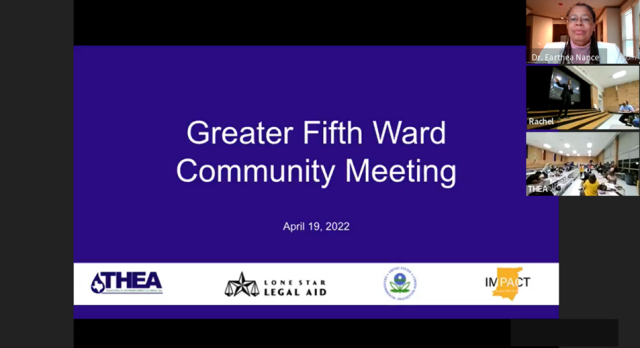Region 6 FY 2022 Accomplishments
Pursuant to a permanent injunction issued by the U.S. District Court for the Western District of Louisiana on August 22, 2024, EPA will not impose or enforce any disparate-impact or cumulative-impact-analysis requirements under Title VI against any entity in the State of Louisiana. Click here for additional and updated information.
The U.S. Environmental Protection Agency is committed to protecting the health and environment of all residents, including those historically marginalized, environmentally overburdened, underserved and living with the legacy of structural racism.
Region 6 established a set of three priorities for fiscal year 2022 derived from President Biden’s executive orders, EPA Administrator Regan’s directives and our knowledge of the region.
Here are some of the accomplishments we’ve made while focusing on these priorities.
Priority 1 - Embed the Administration’s Policy Priorities
This priority includes distributing federal resources to Region 6, embedding climate change and environmental justice into everything we do, implementing follow-up actions for the Region 6 Journey to Justice Tour, producing an environmental justice action plan, and/or producing a climate adaptation report.
Regional Administrator Earthea Nance knows how important it is to partner with people who are most affected by environmental decisions and policies, to hear feedback directly from them and to take action that leads to better protection. Dr. Nance traveled extensively in the Region, visiting communities, cleanup sites, and important infrastructure. She met with communities 29 times in FY2022, in-person and virtually, to establish trust and identify next steps.
During Administrator Regan’s Journey to Justice tour in November of 2021, he met with residents in six locations in Louisiana and Texas, where he saw the impacts of pollution, climate change and crumbling water infrastructure. Region 6 is following up on the Administrator’s tour, taking on each site in turn, knowing it can take years to resolve each one. You can read about these actions on the Journey to Justice website, but we’d like to highlight two of them in this report.
- In St. John the Baptist Parish, we used our authority to require the Denka Performance Elastomers facility to install fenceline monitors to identify sources of emissions onsite, allowing the EPA and communities to better understand air pollutants in a quick, reliable way. Data is posted regularly to our St. John the Baptist Parish website. We also issued a RCRA 3008 Consent Agreement requiring the Denka facility to improve its handling and disposal of chloroprene, the first ever such order addressing chloroprene emissions in Region 6. In October 2022, EPA issued our formal acceptance of a Title VI complaint of discrimination, the first ever acceptance of a Title VI complaint in Region 6.
- At the Union Pacific Railroad Houston Wood Preserving Works site in Houston’s Fifth Ward, we met regularly with the city, the state, non-profit organizations, and community groups to develop a feasible solution for the site. For the first time, we have been at the table with these stakeholders making decisions about sampling and next steps. We have made the case that more protective standards should be used, and we have interpreted data more conservatively to better protect the community. We provided two community technical education sessions for people who live near the site, to help explain the proposed cleanup. We are looking at additional avenues for sampling.
“I love experts like Dr. Nance. She has shown me that she knows how to talk the talk, but also walk the walk with people like me!” – Sandra Edwards, IMPACT 5th Ward
Region 6 managed more than $546 million in funds from the Bipartisan Infrastructure Law and the American Rescue Plan. In addition to grants to other states, Region 6 distributed more than $105 million in BIL funding to the Oklahoma Department of Environmental Quality, Oklahoma Water Resources Board for water infrastructure improvements.
“BIL represents another historic investment into Oklahoma's critical water infrastructure needs. We remain eternally grateful for all of our partners, stakeholders and our delegation and all the hard work they put in behind the scenes to keep Oklahoma moving in the right direction.” – Oklahoma Water Resources Board Executive Director Julie Cunningham
In Region 6, 47 school districts were selected to receive more than $130 million in BIL rebate funds to purchase approximately 350 electric and low-emission school busses in the Clean School Bus program’s first round of funding.
Region 6 received Clean School Bus applications from more than 240 school districts. Ninety percent of these applications and all of the selectees came from priority school districts comprised of high-need, rural and tribal school districts.
Region 6 also embedded environmental justice and/or climate change principles into our decision-making on the Colfax, SPOT, and Corpus Christi projects.
In response to Dr. Nance's visit to Corpus Christi Bay, Chispa Texas Program Director Elida Castillo said, “We feel your support and commitment to our communities. Thank you for standing with us.”
Region 6 staff changed expectations, raised the bar, focused on protection, and deepened engagement with communities beyond previous norms.
For more information about our plans, read our Environmental Justice Action Plan for R6 and the Climate Adaptation Implementation Plan for R6.
Priority 2 - Make Environmental Justice and Climate Change Top Priorities for All Region 6 Programs
This priority includes hiring crucial staff, training employees on environmental justice and climate change, positively protecting public health and the environment, identifying EJ and climate impact areas in Region 6, evaluating environmental impacts of the energy transition, improving communication with communities, enhancing relationships with states and tribes, and/or improving staff morale.
To help identify EJ impact areas, we created a regional map using EJ Screen that identified more than 16,000 census block groups in R6 with potential EJ concerns, which is more than 54% of all Region 6 census block groups. This map is being used to orient staff to the geographic extent of environmental justice problems in Region 6, and as an overlay for further analysis of impacts on EJ communities.
To improve our relationships with states, Dr. Nance participated in 28 meetings with Region 6 state officials, including monthly one-on-one meetings with the five state environmental heads, three Environmental Council of the States events, delivery of keynote addresses at events attended by state officials, press events with state officials, and collaborations with other agencies on project delivery.
We also strengthened relationships across the board by hosting a successful National Brownfields Conference in Oklahoma City, and providing access to grants that help maximize economic, environmental and social performance to more than 2,000 attendees from across the country. We added a first-ever environmental justice caucus for community leaders to provide feedback and insights to EPA staff and managers as well as the first all-tribe meet and greet.
Region 6 strengthened relationships with tribes by participating in multiple formal SAFETEA sessions, National Tribal Operations Committee and Regional Tribal Operations Committee sessions, and formal consultations with tribes. Dr. Nance visited several tribes in person and toured their lands. Region 6 staff participated in many other meetings with tribes.
EPA is in the process of updating the National Emission Standards for Hazardous Air Pollutants (NESHAP) under the Clean Air Act to reflect our increased understanding of risk from ethylene oxide (EtO) and technologies available to reduce this risk. We reached out to affected communities in Region 6 with four public meetings to explain EtO risk to residents in Ardmore, Oklahoma; Athens, Texas; Laredo, Texas; and Santa Teresa, New Mexico. Dr. Nance attended the Laredo meeting to hear community concerns first-hand. Region 6 feedback prompted the Agency to revise the format of the meetings and improve the way ethylene oxide risk was communicated in these public meetings nationwide. You can learn more about EtO, facilities that use it, and how EPA is reducing EtO risk to communities at our EtO website.
Priority 3 - Use Local Action to Impact National Policy
This priority includes improving air monitoring, our understanding of Superfund site risk, how we communicate risk, and/or the evaluation process for Class VI wells (wells that inject carbon dioxide for the purposes of long-term storage, also known as CO2 geologic sequestration).
Region 6 contributed to EPA’s national approach to evaluating and permitting Class VI wells that sequester carbon. We developed an innovative safe siting methodology and a whole-of-government approach for identifying the impacts of carbon capture and sequestration on communities. We worked with EPA’s Region 9 and the Department of Energy to deliver virtual training sessions with community groups. We are also active members of EPA’s Class VI and Carbon Capture Utilization and Storage workgroups.
One of the communities visited by the PAT was Mossville, Louisiana. Concerned Citizens of Mossville President Carolyn G. Peters said, “The Concerned Citizens of Mossville would like to say, ‘thank you,’ to recently appointed Region 6 Administrator, Dr. Earthea Nance, for giving attention to the causes and concerns of our Mossville community. CCOM looks forward to future collaborations with Dr. Nance and her staff with a path of open communication.”
Region 6 developed a new model for air monitoring called the Pollution Accountability Team, or PAT. The PAT model involves mobile monitoring vehicles traveling in the vicinity of selected facilities, a monitoring airplane flying over the facilities, and certified inspectors with handheld instruments entering the facilities as needed to identify sources of facility emissions.
In advance of our field effort, the path of the mobile monitoring vehicle was determined in collaboration with local community members. The resulting data will be posted on our website and the projected outcomes will be discussed with the communities. The PAT approach is now ready for future investigations at other sites in the region.



